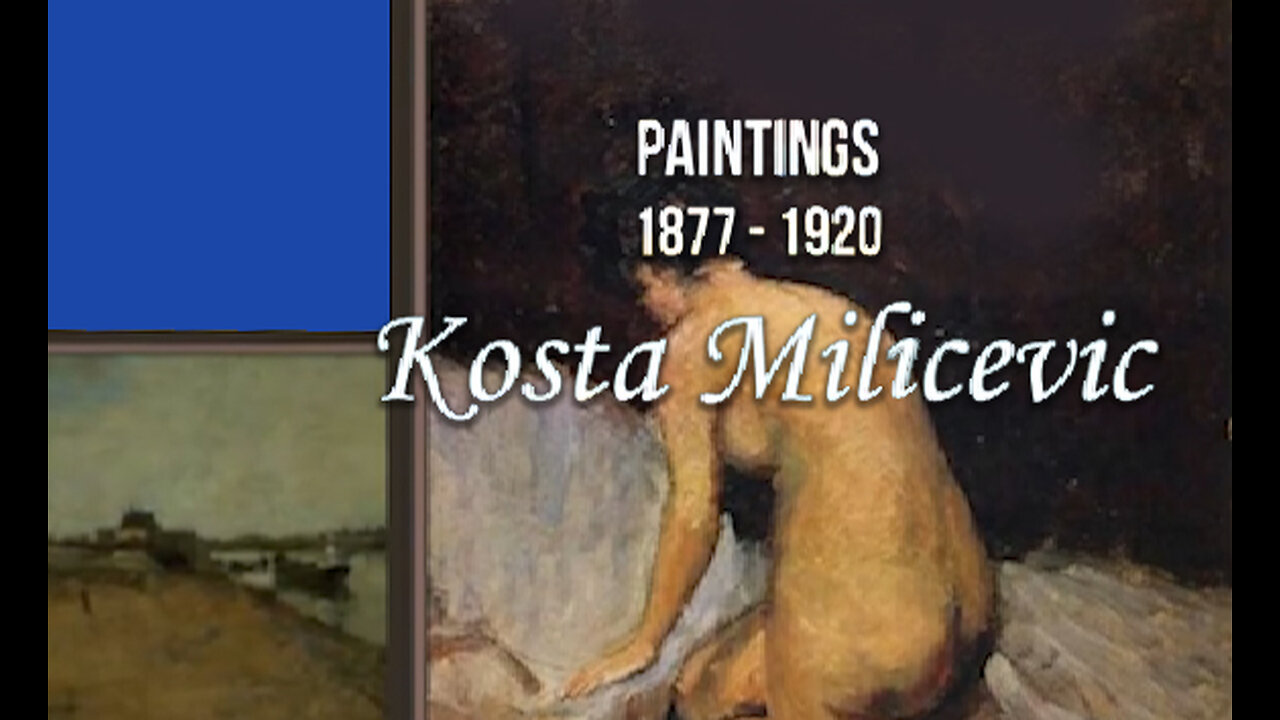Premium Only Content

Kosta Miličević - Paintings (1877 – 1920)
Kosta Miličević (Serbian Cyrillic: Коста Миличевић; 3 June 1877 – 12 February 1920) was a Serbian impressionist painter, known mostly for his landscapes.
Kosta Miličević was born to a clerical family, with a history of service in the priesthood. As a young man, he went to Belgrade, where he studied with Kiril Kutlik who operated a famous painting school. He continued his training, under difficult financial conditions, in Prague, Vienna, where he worked with the portrait painter, Heinrich Streblow (1862-1925) and Munich. Until 1910, he was an informal student at the arts and crafts school of Rista and Beta Vukanović. That same year, he became a member of Lada [sr], an art association.
In his early period, he painted in the Academic style, as taught in Germany, then was attracted to Art Nouveau. After becoming acquainted with the works of Nadežda Petrović and Milan Milovanović, he sought to create a more personal style. He finally settled on a free, Impressionistic approach, brought to fruition during a stay at an artists' colony in Savinac (now part of Belgrade). His first success came at the Fourth Yugoslav Art Exhibition of 1912.
He was inducted into the army during World War I, briefly served as a soldier, then became an official War Painter for the Supreme Command in Corfu. Only five paintings are known to have survived from this period.
After the war, he taught evening classes at the Vukanovic's arts and crafts school.[1] His early death was probably due to tuberculosis.
His Corfu paintings combine the melancholy of his character, the fatalism of his life and the tragic fate of his generation" (Trifunović, 20142, p. 91).
Now the quick and free stroke of the brush on the canvas is fully developed, which corresponds to the importance of emphasizing the coloristic elements of the picture and the overall atmosphere at the expense of the form and matter of what is represented. Several more seascapes of Corfu from 1918 have been preserved, with simple names (Corfu I, Corfu II, Motif from Corfu, Landscape from Corfu...) done in a similar spirit, broad strokes, fast, thick. The landscapes of the island of Corfu and its shores exude melancholy, bearing in mind Milicevic's hypersensitivity and the general context of the brutal wartime in which they are created, but at the same time, the light of the dazzling Mediterranean sun and the vivid palette of colors dominate these sea scenes.
There is no military theme in them, but they are images of war: those green strips of lonely land lost in the infinity of the sky and sea, those blue pearls that roll on the sunny sea shores carry war in their subtext, in the resistance and negation of war, in the green cry of a people who had to endure a world cataclysm and overcome a national disaster. In these paintings, Miličević most fully expressed himself and his world... Miličević created the first impressionist paintings of the French type, although he never saw France. Finished, mature and clean, the landscapes of Corfu happily completed the process of affirmation of light that began in 1912 and 1913.
Kosta Miličević seems to have borne all the tragedy of his generation on his own shoulders. This is also evidenced by a gloomy painting, Winter View of Belgrade (1920), probably among the last he painted, but decisively emphasizing his superb impressionism. Exhausted and still insufficiently recovered from his illness, he died in February 1920 in Belgrade.
-
 2:03:51
2:03:51
TimcastIRL
4 hours agoTrans Minneapolis Shooter BLAMED Massacre On Mom & Gender Transition | Timcast IRL
152K165 -
 47:29
47:29
Man in America
10 hours agoIT DOESN'T ADD UP: The Trans Shooter's Story Is FULL of Holes
19K18 -
 LIVE
LIVE
StevieTLIVE
3 hours agoFriday Night Warzone HYPE
219 watching -
 LIVE
LIVE
SynthTrax & DJ Cheezus Livestreams
1 day agoFriday Night Synthwave 80s 90s Electronica and more DJ MIX Livestream Michael Jackson / AI Art Compilation Edition
239 watching -
 1:03:57
1:03:57
Sarah Westall
3 hours agoMara Lago Accord Joins the Fed, Fed Waves the White Flag & more w/ Andy Schectman
11.7K -
 LIVE
LIVE
I_Came_With_Fire_Podcast
1 day ago*BREAKING* Special Guest Katarina Szulc
283 watching -
 LIVE
LIVE
megimu32
3 hours agoOFF THE SUBJECT: FAFO Friday! Bodycams & Mario Kart Mayhem!
105 watching -
 55:36
55:36
Flyover Conservatives
22 hours ago4 Strategies to Create Opportunity from Nothing - Clay Clark | FOC Show
19.1K -
 1:49
1:49
Gaming on Rumble
9 hours agoWhat is the Rumble Creator Program!?!? (Active Premium Creators) | Lvl UP
22.5K2 -

Midnight In The Mountains
6 hours agoGaming w/ PER·SE·VER·ANCE | Midnights Play Fortnite | Split Screen Action!
14.3K2